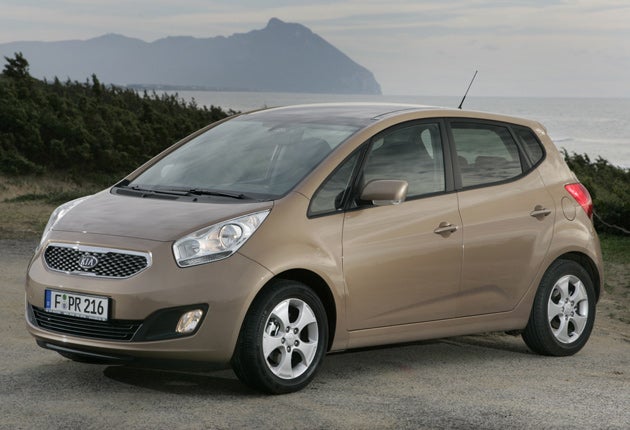Kia Venga
Kia have produced a car for grown-ups...with a seven-year warranty

Your support helps us to tell the story
From reproductive rights to climate change to Big Tech, The Independent is on the ground when the story is developing. Whether it's investigating the financials of Elon Musk's pro-Trump PAC or producing our latest documentary, 'The A Word', which shines a light on the American women fighting for reproductive rights, we know how important it is to parse out the facts from the messaging.
At such a critical moment in US history, we need reporters on the ground. Your donation allows us to keep sending journalists to speak to both sides of the story.
The Independent is trusted by Americans across the entire political spectrum. And unlike many other quality news outlets, we choose not to lock Americans out of our reporting and analysis with paywalls. We believe quality journalism should be available to everyone, paid for by those who can afford it.
Your support makes all the difference.Kia Venga. Clearly another new car from that home of the most-improved motor industry products of the past five years, South Korea. As with consumer electronics, Korean cars have evolved from cheap-but-adequate to good-value and fully competitive. The country of origin is now incidental.
So, it is less significant than it might once have been that the new Venga, a compact MPV in the vein of the Fiat Idea (no longer sold in the UK) or the Vauxhall Meriva (about to be replaced by a cool-looking new one) is made in Slovakia and was designed and engineered in Germany. It is, effectively, a European car, and a good-looking one too. The name has connotations of jenga, the game in which you remove wooden bricks from a tower and hope it doesn't fall down, and of Veng, a large supplier of car body panels to the non-franchised repair trade, but it comes from the infinitive form of "arrive" in Spanish.
Kia recently launched another compact MPV, called Soul, but it is conceived around its looks and, in the youthful, urban market, those looks are meant to attract. The Soul is much like a 4x4 with military genes, but set up for high-volume socialising. The Venga, by contrast, is the sensible, sophisticated sibling, built on much the same mechanical base but designed for those who just want a useful car. And the lure of a seven-year, 100,000-mile warranty could make them want this car quite a lot.
The Venga's, er, arrival is well timed, too, as buyers consider smaller, cheaper cars and discover that they are really the same size as cars from the class above used to be before the curious addition of automotive obesity took hold. The Venga really is as big as a compact, five-seater MPV needs to be. It does the practical things expected of an MPV, too. The rear seats slide to alter the ratio of people space to boot space, and, as you fold down the backrests, the cushions lower themselves so the backrests occupy their former space.
It would stretch a point to describe the Venga's interior as plush, but there's an air of quality which cements the notion of a fully developed, full-price, competitive car. Top-trim Venga 3 versions get a glossy black finish on the centre console, a panoramic glass sunroof, and automatic air-conditioning, plus Venga 2 niceties including a leather-rim steering wheel, aluminium alloy wheels and an iPod plug. But even a Venga 1 has manual air-con, electric front windows, remote-control central locking, and a USB port in its stereo system. Options include a rear-parking camera with display screen that appears within the interior mirror.
The Venga's wedged stance, with rear wheels pushed well back, gives the impression of a car which sits well on the road and might be fun to drive. So it proves, up to a point, but there is a slight disconnect between the various flavours of European thinking. The way the Venga rides over bumps (noisily but with commendable suppleness) and the way it handles corners (capably but with the artificial, glutinous steering typical of an electrically power-assisted system) has been deemed unsuitable for the UK, and our cars will have different suspension settings. They should feel sharper and ride more quietly, but given the industry-wide agreement that if a car works on the UK's crumbling roads it will work anywhere, it's strange the two specifications co-exist.
The 1.6-litre Kia/Hyundai diesel is a great engine, unfortunately, it is not offered in the Venga, which has a new 1.4-litre unit whose 90bhp output feels reluctant to reveal itself. The response from low speeds is torpid until the turbocharger stirs itself, the power delivery is gruff at best but it does have a low 117g/km CO2 figure.
You can have a 123bhp, 1.6-litre petrol engine but its efforts are thwarted by the compulsory automatic transmission with just four gears. Which leaves the 1.4-litre petrol engine, 90bhp again but delivered with smoothness and verve. The cheapest Venga comes with this engine and entirely adequate equipment, so at £11,495 it's the one to have. Go for a grander version and you'll wonder why you bothered.
The Rivals
Citroën C3 Picasso 1.4 VTi VT: £11,795
Big for a "small" car. Very roomy, wacky styling, comfortable, surprisingly fluent to drive. And a great view out. Recommended.
Nissan Note 1.4 Visia: £10,295
Recently refreshed, the spacious Note is a responsive, satisfying drive and a practical family MPV. Makes even the Kia look a little expensive.
Renault Grand Modus 1.2 Expression: £11,516
Longer, roomier Modus works as a mini-MPV better than the original. Came too late. Worth a look, though.
Join our commenting forum
Join thought-provoking conversations, follow other Independent readers and see their replies
Comments